A food processor excels at chopping ingredients quickly and uniformly due to its powerful motor and sharp, flat blades designed specifically for cutting and mixing thick or dense foods. Blenders, while capable of chopping, are optimized for blending liquids and creating smooth textures, often resulting in a less consistent chop when handling solid ingredients. Choosing a food processor over a blender for chopping tasks ensures greater precision and efficiency in preparing vegetables, nuts, and other dense items.
Table of Comparison
| Feature | Food Processor | Blender |
|---|---|---|
| Primary Use | Chopping, slicing, shredding | Smooth blending, pureeing liquids |
| Chopping Efficiency | High - precise, even pieces | Low - uneven, mushy texture |
| Blade Design | Wide, sharp multi-purpose blades | Fixed blades for liquid blending |
| Speed Settings | Multiple speeds plus pulse | Limited speeds, usually one to three |
| Best For | Vegetables, nuts, dough, firm ingredients | Soups, smoothies, soft fruits |
| Texture Control | High - controlled chopping | Low - tends to puree food |
Food Processor vs Blender for Chopping: Key Differences
Food processors excel at chopping due to their wide, sharp blades and powerful motor, allowing for consistent and efficient cutting of vegetables, nuts, and other ingredients. Blenders feature narrower blades designed for pureeing and blending liquids, making them less effective for precise chopping tasks. Choosing between a food processor and blender for chopping depends on the texture desired, with food processors providing more control and uniformity.
How Each Appliance Works: Chopping Mechanisms Explained
Blenders use high-speed rotating blades that create a vortex, pulling ingredients towards the center for smooth blending, but they can struggle with uniform chopping due to their rapid blade motion. Food processors feature a wider bowl and sharp, fixed blades rotating at moderate speeds, allowing for precise and consistent chopping of vegetables and nuts. The chopping mechanism in food processors offers better control over texture, making them ideal for coarse or chunky cuts compared to the fine, pureed results typical of blenders.
Chopping Performance: Food Processor vs Blender
Food processors excel in chopping performance due to their wide, flat blades and spacious bowls that allow consistent, even processing of solid ingredients like nuts and vegetables. Blenders typically use sharp, tall blades designed for liquefying and pureeing, which can struggle to achieve uniform chopping without overprocessing. For precise chopping tasks, food processors offer superior control and texture customization compared to blenders.
Precision and Consistency in Chopping
A food processor offers greater precision and consistency in chopping due to its specialized blades and adjustable speed settings, ensuring uniform cuts across various ingredients. In contrast, a blender typically produces less consistent results because its high-speed blades are designed for blending rather than controlled chopping. For tasks requiring fine, even chopping, a food processor is the superior choice in terms of accuracy and repeatability.
Ease of Use: Which is Simpler for Chopping Tasks?
Food processors generally offer greater ease of use for chopping tasks due to their wider, more stable bases and larger capacity bowls that accommodate bigger quantities effortlessly. The pulse function on most food processors allows precise control over chopping consistency, making it simpler to achieve uniform results without over-processing. In contrast, blenders often require smaller batches and manual stopping to prevent pureeing, which can complicate straightforward chopping tasks.
Time Efficiency When Chopping Ingredients
A food processor significantly reduces chopping time for larger quantities of ingredients due to its powerful motor and wide, sharp blades designed for bulk processing. Blenders, while effective for pureeing, typically require smaller batches and more time to achieve consistent chopping results because of their narrow blades and less efficient chopping mechanism. Choosing a food processor enhances time efficiency when prepping diverse, chunky ingredients quickly in the kitchen.
Best Foods for Chopping: Food Processor vs Blender
Food processors excel at chopping dense or large quantities of foods like nuts, vegetables, and cheese, delivering consistent, even cuts thanks to their wide, flat blades and powerful motor. Blenders, while versatile, struggle with chopping tasks due to their narrow, high-speed blades which are better suited for purees and liquids rather than coarse chopping. For optimal chopping results, choosing a food processor ensures precision and efficiency with foods like onions, carrots, and herbs, while blenders are ideal for smoothies and soups where fine blending is required.
Cleaning and Maintenance Comparison
A food processor typically has more parts, such as multiple blades and a wider bowl, making cleaning more time-consuming compared to a blender's simpler design with fewer components. Blenders often feature detachable, dishwasher-safe blades and containers, which streamline maintenance and reduce effort. Regular thorough cleaning of both appliances is essential to avoid residue buildup and ensure longevity, but blenders generally require less frequent deep cleaning for chopping tasks.
Cost Considerations: Value for Chopping Needs
A food processor generally offers better value for chopping needs due to its specialized blade systems and larger bowl capacity, which can handle tougher ingredients with ease. Blenders tend to be less expensive but may struggle with uniform chopping, making them less efficient for precise food preparation. Investing in a food processor often results in cost savings over time by reducing the need for multiple kitchen appliances.
Which Should You Choose for Efficient Chopping?
A food processor offers superior chopping efficiency with its sharp, wide blades and powerful motor designed for handling tougher, larger quantities of ingredients. Blenders, while capable of chopping, are better suited for liquids and soft mixtures due to their narrower blades and high-speed settings that can over-process solid foods. For consistent, precise chopping of vegetables, nuts, and herbs, a food processor is the more practical and effective choice.
Food processor vs blender for chopping Infographic

 productvia.com
productvia.com